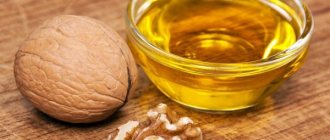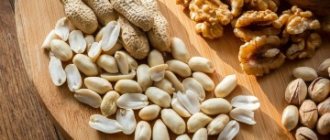Every mother dreams of her little miracle growing up healthy and strong. And mother's milk is the main guarantee of the successful development of strong babies. What to do when there is not enough milk? Milk with walnuts for lactation, the recipe of which will always save you - that’s what is the savior.
That’s right, the methods of great-grandmothers immediately come to mind, who, without cutting-edge drugs, managed to raise entire generations of healthy people (including our parents). One such recipe for increasing lactation is milk with walnuts. After all, the nut itself is an irreplaceable source of many beneficial substances. To prevent any disease, it is enough to eat a handful of these nuts a day. Is this true or a myth? Let's try to give an exact answer to this question.
Here the opinions of experts differ. Some argue that breastfeeding women can and should add walnuts to their daily diet. Others – not so categorically, but against it. Why? Let's figure it out.
All in favor, tasty, safe
Undoubtedly, the usefulness of walnuts is invaluable. It contains a whole complex of natural minerals:
- Zinc (cell growth, tissue growth, reproduction, brain);
- Iron (DNA, oxygen metabolism, hormones);
- Iodine (body biochemistry, thyroid gland);
- Copper (muscles, internal organs, blood);
- Unsaturated fatty acids;
- Fats;
- Proteins;
- Other;
And vitamins:
- Group B (cell metabolism);
- A (formation of bones, teeth, metabolism);
- E (antioxidant, skin, reproductive system);
- P (regulates pressure);
- C (immunostimulant);
- K (protein synthesis, blood clotting);
- Other.
As you can see, everything necessary for a successful start in the development of a little person is present. Therefore, walnuts for lactation are recommended for nursing mothers. To improve not only the quantity of milk, but also its quality. Especially if the baby is not gaining weight.
How to stimulate lactation in case of allergy to walnuts?
First of all, do not forget that the most effective way to maintain your milk supply at the proper level is to feed on demand and have your baby breastfeed frequently. "Demand creates supply". If the mammary gland rarely empties, the body receives information that milk is not really needed, and less of it is produced.
You also need to ensure that the baby is properly attached (not only the nipple, but also the areola, especially its lower part, should enter the mouth). Otherwise, sucking will not be as effective, and painful nipple cracks may occur.
You should not neglect night feedings, since prolactin (a hormone that stimulates milk production) is produced in the mother’s body at night. Even if the baby sleeps well, you should try to feed him twice from 3.00 to 8.00 in the morning.
If even if all these conditions are met, the problem is not solved, it is better not to let things take their course, but to contact a breastfeeding specialist (on forums, by phone, or by inviting them home). Also, be sure to talk to your pediatrician, because weight loss may not be due to a lack of milk at all, but to some other disease.
In conclusion, we note that if both the baby and the mother tolerate walnuts well, then they can be consumed during breastfeeding in the amount of two to three walnuts per day, this will be quite enough to demonstrate their beneficial properties.
It is better to buy thermally unprocessed and unshelled nuts. Bon appetit! Subscribe to our VKontakte group
What's the "cons", stop - allergies
Just as every medicine has contraindications, this method also has its “buts”:
- It should be remembered that richer milk may stagnate. And cause blockage of the mammary gland ducts. What will lead to
- Animal milk and nuts are included in the group of so-called natural allergens (although walnuts are the least dangerous of all). Both mother and baby may experience all sorts of allergic reactions, such as:
- Stomach upset;
- Colic;
- Bloating;
- Changes in the skin (rash, redness);
- Inflammatory processes;
- Edema.
In this case, it is advisable to consult a pediatrician and it is better to avoid the use of such products.
In general, everything in our world is individual. Some eat chicken eggs and fish with pleasure all their lives, but they end up wasting them on meat, others are omnivores, and some cannot even look at a good half of the existing food. Therefore, the main thing is a sense of proportion.
Why is breastfeeding necessary?
Breastfeeding has not only nutritional, but also great psychological significance, influencing the development of mother-child relationships in subsequent age periods**. According to studies conducted in Australia, among such factors of a child’s psychological development as age, education, the presence of bad habits in the mother, lack of breastfeeding for at least 6 months has a 1.45 times greater impact on the child’s mental ill-health than others** *.
Miracle recipe
Walnuts with milk for lactation are very easy to prepare. You only need 1.5 glasses of cow's milk and 50 grams of kernels. They need to be crushed and poured into a thermos. Boil the milk. Pour boiling milk over the nuts and let steep for about two hours. You should drink this tincture throughout the day. You can also add one teaspoon of honey to the infusion.
Sometimes they also replace cow's milk (again due to allergies) with goat's milk. In this case, goat milk is diluted by a third with water. Add 1/3 plain water to 2/3 milk, due to its high fat content.
In their pure form, the kernels are eaten in small quantities, no more than 30 grams per day.
Milk volume, fat content and other problems
Why do you think you don't have enough milk? The child does not eat enough, cries, often asks for breastfeeding?
Colostrum, milk, its quantity...
Are your breasts soft and producing a small amount of light brown secretion? That's right, it's colostrum. In the first month after birth, lactation begins to develop. It goes differently for everyone. And it doesn't all start with milk.
After giving birth, your glands produce colostrum rather than milk. This is a nutritional concentrate; on the first day, the baby only needs 5 ml per feeding. Your glands produce up to 100 ml of colostrum per day, and your breasts just seem empty. For the first 3 days you will feed the baby this invaluable concentrate.
When feeding, keep in mind that the baby requires 10 ml of mature milk for every day of life. That is, on the 3rd day, the baby needs an average of 30 ml of milk for each feeding. Of course, the volume of nutritional substance varies and depends on the volume of the baby’s stomach and its weight.
How much should an infant eat?
| Child's age | Amount of milk consumed per feeding, ml | Amount of milk consumed per day |
| 3-4 days | 20-60 | 200-300 ml |
| 1 Week | 50-80 | 400 ml |
| 2 weeks | 60-90 | 20% of the child's weight |
| 1 month | 100-110 | 600 ml |
| 2 months | 120-150 | 800 ml |
| 3 months | 150-180 | 1/6 of the child's weight |
| 4 months | 180-210 | 1/6 of the child's weight |
| 5-6 months | 210-240 | 1/7 of the child’s weight (800-1000 ml) |
| 7-12 months | 210-240 | 1/8-1/9 of the child's weight |
Then, on days 4-5, colostrum is replaced by transitional milk, and only from day 6 your glands are filled with mature milk. The rate of replacement of colostrum with mature milk varies among women. Therefore, pediatricians recommend taking your time with ways to enhance lactation. Feed your baby on demand. In the first month, babies should literally “hang on their chest.”
Neonatologists say that in the first 28 days of life a child wants to feed from 8 to 20! once a day, and this is the norm. If your baby requires breastfeeding every hour, this does not mean that you have little milk or that it is not high in calories.
Remember that in primiparous women, mature milk will appear 6-10 days after natural delivery.
Now about fat content
Your glands may produce enough secretion, but the milk may lack fat content. We tell you how to check the fat content of milk at home in a separate article. You can also have your milk tested. Read about this in our articles on this site.
Storage conditions
Housewives have little tricks in storing food. This also applies to nuts.
For example,
- You should eat nuts immediately after peeling them.
- Can be stored in the freezer.
- It is better to purchase uncleaned, in shell (from a hygienic point of view).
If you don’t know whether you or your baby will develop an allergy or not, try eating one nut first and observe.
Remember, no one can help your little man better than you. Take care of yourself, your health, don’t worry about trifles, and everything will be fine.
What affects lactation
Lactation in women is influenced by various factors, which can be divided into 4 groups: psychological, organizational, social and medical. Organizational and medical factors are mainly important in the early stages of breastfeeding, while psychological and social factors are of long-term effect.
Organizational and medical factors
These include factors that depend on the correct actions of medical workers in the postpartum period. Staying together of mother and child in the maternity hospital, early breastfeeding, lack of stimulation of labor and prelactation feeding, feeding from the first days of the baby’s life, timely and reasonable assistance from medical personnel**. An important aspect is the early attachment of the baby to the breast. Immediately after birth, the baby is placed on the mother's stomach so that she can attach the baby to her breast. Early contact between the newborn and mother stimulates the production of breast milk in greater volumes. In addition to health care providers, lactation consultants who specialize in helping mothers can help develop proper breastfeeding practices.
Psychological and social factors
The psychological state of the mother during the period of feeding the child plays an equally important role. The established dominance of motherhood and lactation, comfortable conditions in the family, the mother’s ability to relax during feeding, and the absence of stressful situations have a positive effect on the nature of lactation and its duration**. Since milk comes in differently for different women, if milk is not enough, do not despair at the first stage and remain positive and confident in your abilities. Worry only reduces your milk supply. It is important not to start artificial feeding while there is still hope of establishing breastfeeding*****.
Proper nutrition plus stimulation
Our research has shown that among the causes of hypogalactia, a large place belongs to the nutritional factor. Therefore, first of all, it is necessary to rationalize the mother’s diet. It is especially important to meet the need for protein, vitamin and mineral components of the diet of pregnant women and nursing mothers. You should not forget about the drinking regime - from 1.5 to 2 liters per day, including liquid meals. It may be necessary to prescribe lactogenic drugs, i.e. increasing the production of milk, foods and drinks, physiotherapeutic procedures and medications, vitamin and mineral components, dietary supplements1.
Let's list industrial products that can stimulate lactation. We divided specialized products into five groups (see table).
Group I. Preparations that correct the diet according to basic nutritional factors, especially animal protein, fats, the whole range of minerals, trace elements and multivitamins.
"Femilak" contains milk protein, enriched with a particularly important substance - taurine, present in human milk, 15 vitamins, and corn oil. The use of the Femilak product during pregnancy has a positive effect on the health of the expectant mother and the proper development of the fetus, and during breastfeeding it promotes sufficient lactation and improves the composition of mother's milk. “Enfa-mama”, “Dumil Mama plus” are similar products, but they do not contain taurine. Nursing mothers also successfully use the domestic product "Olympic", created for athletes. "Olympic" is a dry fortified mixture based on soy protein.
Group II. Products that correct the diet and are enriched with a lactogenic additive.
This group includes a new product for nursing mothers, “Milky Way,” developed by Vitaprom LLC together with the State Research Institute of Nutrition of the Russian Academy of Medical Sciences. It contains whole skimmed cow's milk powder, soy protein solate, sugar, chicory, galega herb extract, dietary fiber, vitamins, and mineral salts.
Galega herb extract is a powerful lactogenic factor. Clinical studies have shown that the product is well tolerated by nursing mothers and infants. The product effectively enhances the lactation function of a nursing mother. It can be used from the first days of lactation by women at risk for hypogalactia (slow “start” of lactation, early transfer to artificial feeding of previous children).
III. Products of plant origin with lactogenic properties, in the form of juices, drinks, teas.
Among the plants that enhance lactation, a large role is assigned to food and spicy-flavoring ones. These include carrots, licorice, lettuce, radish, cumin, dill, nettle, dandelion, fennel, oregano, lemon balm, anise, yarrow, rose hips, hazelnut and others. Infusions and decoctions are prepared from these plants and taken in the form of drinks.
Signs of insufficient lactation
To assess the adequacy of lactation, a thorough analysis of the child’s behavior, frequency of urination, and the nature of stool is necessary. Possible signs of insufficient lactation are:
- the child’s screaming and restlessness during or immediately after feeding;
- the need for frequent breastfeeding;
- long-term feeding, during which the child makes a lot of sucking movements in the absence of swallowing movements;
- the mother feels that the mammary glands are quickly completely emptied when the baby is actively sucking; when pumping after feedings, there is no milk;
- restless sleep, frequent crying, “hungry” cry;
- low rate of baby weight gain;
- infrequent bowel movements and urination*.
Next stages of lactation
At the next stages of lactation it is important:
- pay special attention to night feedings; the maximum amount of the hormone prolactin (responsible for the secretion of breast milk) is produced from 4 to 7 am;
- Healthy food;
- if necessary, include lactation products with a lactogon effect in your diet;
- establish a rational daily routine for adequate sleep and rest;
- remain calm and have a positive, positive feeding attitude in all situations.











